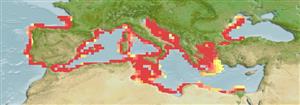Cephalopoda |
Sepiida |
Sepiolidae | Sepiolinae
Environment: milieu / climate zone / εύρος βάθους / distribution range
Οικολογία
; εύρος βάθους 27 - 376 m (Αναφ. 1695). Subtropical; 46°N - 31°N, 11°W - 32°E (Αναφ. 1695)
Northeast Atlantic and the Mediterranean: Portugal.
Length at first maturity / Μέγεθος / Weight / Age
Γεννητική Ωρίμανση: Lm ? range ? - ? cm Max length : 1.9 cm ML αρσενικό/απροσδιόριστο; (Αναφ. 1695); 3 cm ML (female)
Found in sandy and muddy substrate along coasts, in depths between 27 and 376 m, often in areas colonized by the seagrass, Posidonia oceanica. A benthic, gregarious species; able to leave the bottom and undergo significant vertical migrations. Spawning may commence as early as spring and through autumn in the Mediterranean. In aquaria, females were observed to spawn intermittently over a 2-week period and then died. Frequently captured as a bycatch of trawl and purse seine fisheries and may be an abundant component of bobtails marketed locally (Ref. 1695).
Life cycle and mating behavior
Γεννητική Ωρίμανση | Αναπαραγωγή | Γεννοβολία | Eggs | Γονιμότητα | Larvae
Members of the class Cephalopoda are gonochoric. Male and female adults usually die shortly after spawning and brooding, respectively. Mating behavior: Males perform various displays to attract potential females for copulation. During copulation, male grasp the female and inserts the hectocotylus into the female's mantle cavity where fertilization usually occurs. Life cycle: Embryos hatch into planktonic stage and live for some time before they grow larger and take up a benthic existence as adults.
Jereb, P. and C.F.E. Roper (eds.) 2005 Cephalopods of the world. An Annotated and Illustrated catalogue of Cephalopod species known to date. Vol. 1. Chambered nautiluses and sepioids (Nautilidae, Sepiidae, Sepiolidae, Sepiadariidae, Idiosepiidae and Spirulidae). FAO Spec. Cat. Fish. Purp. 4(1):262p. Rome: FAO. (Αναφ. 1695)
IUCN Red List Status
(Αναφ. 130435: Version 2025-1)
CITES status (Αναφ. 108899)
Not Evaluated
Not Evaluated
Threat to humans
Harmless
Human uses
| FishSource |
Εργαλεία
Περισσότερες πληροφορίες
Τροφική ΟικολογίαFood items (preys)
Σύσταση δίαιτας
Κατανάλωση τροφής
Θηρευτές
Population dynamicsΑύξησηMax. ages / sizesLength-weight rel.Length-length rel.Length-frequenciesMass conversionΑφθονία Life cycleΑναπαραγωγήΓεννητική ΩρίμανσηΓονιμότηταΓεννοβολίαEggsEgg developmentLarvae PhysiologyΚατανάλωση οξυγόνου
Human RelatedStamps, coins, misc.
Διαδικτυακές πηγές
Estimates based on models
Preferred temperature
(Ref.
115969): 13.2 - 16.3, mean 14.7 (based on 96 cells).
Fishing Vulnerability
Low vulnerability (10 of 100).
Price category
Unknown.
